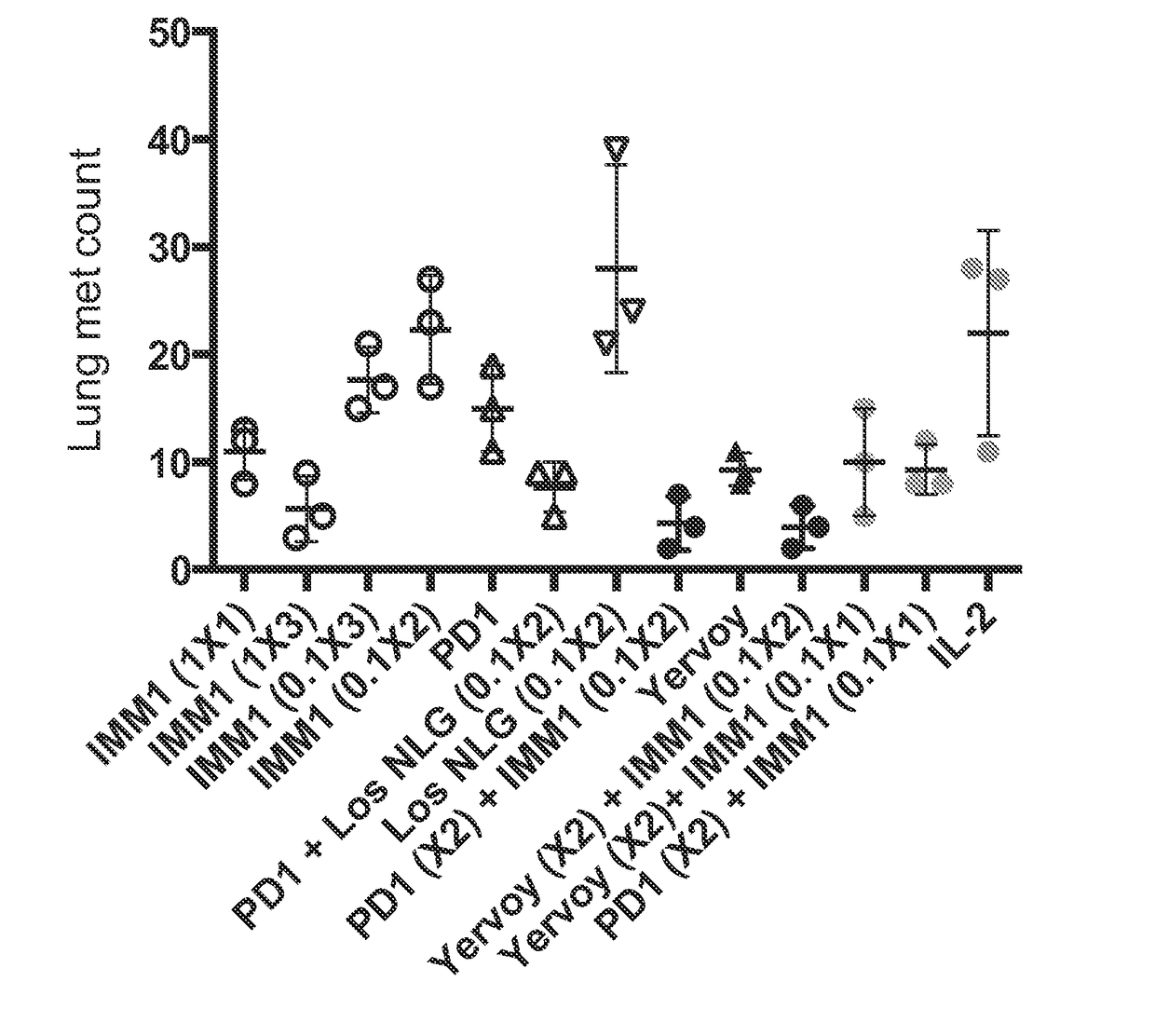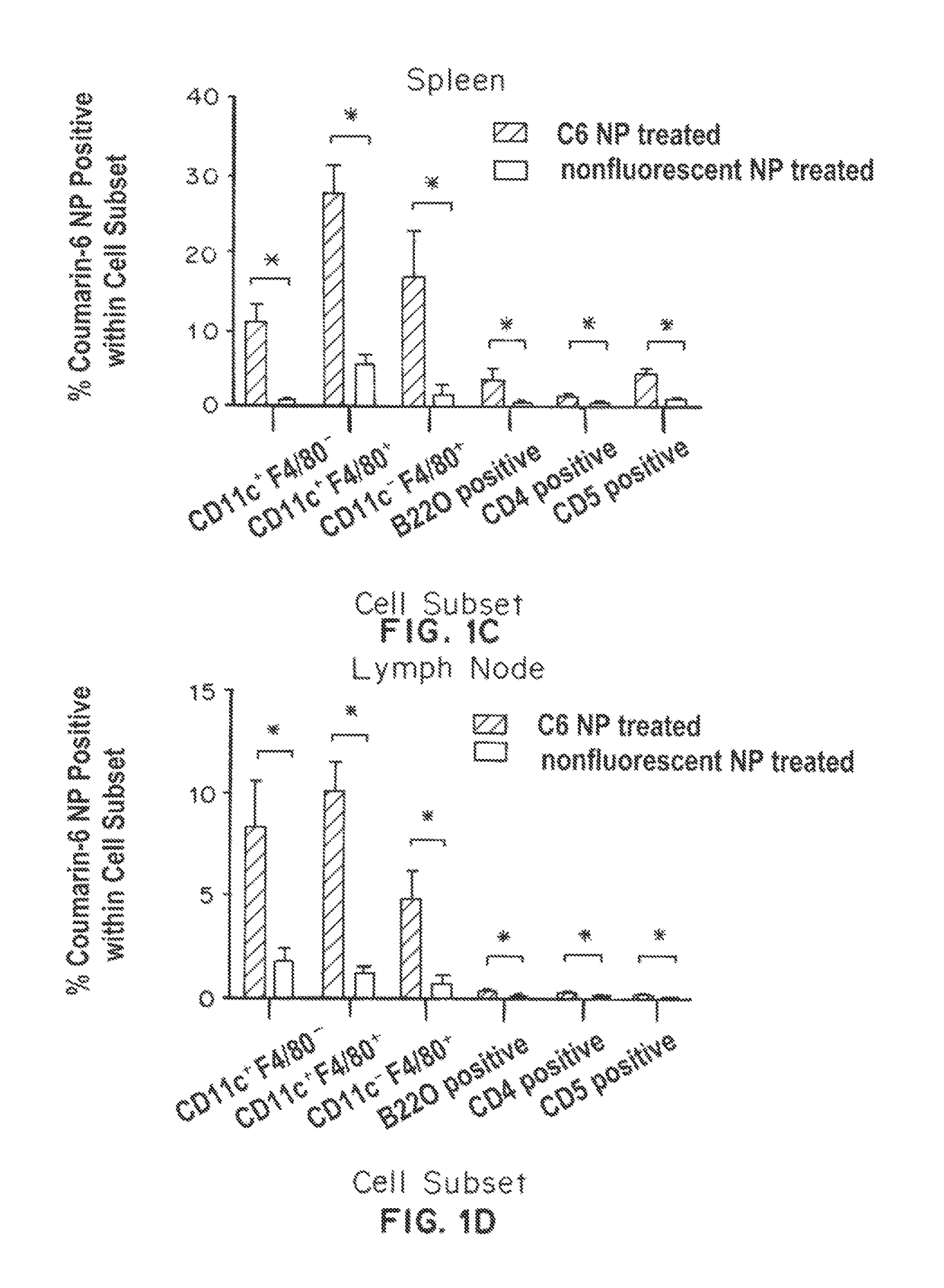Modular particles for immunotherapy
a technology of immunotherapy and modules, applied in the field of nanoparticulate compositions, can solve the problems of difficult drug delivery in combination therapy, and achieve the effect of reducing one or more symptoms of cancer
- Summary
- Abstract
- Description
- Claims
- Application Information
AI Technical Summary
Benefits of technology
Problems solved by technology
Method used
Image
Examples
example 1
Trafficking of Nanoparticles to Spleen and Presentation to Dendritic Cells
[0330]Materials and Methods
[0331]Nanoparticles were made and characterized according to previously described protocols (Look, et al., J. Clinical Investigation, 123(4):1741-9 (2013), Shirali, et al., Am. J. Transplant, 11(12):2582-92 (2011)). PLGA particles, fluorescent probe (COumarin 6) was dissolved with PLGA in ethyl acetate, and emulsified with poly(vinyl alcohol) and avidin-palmitate using a sonicator probe. PLGA particles were subsequently hardened, washed, and then lyophilized. Biotinylated poly(ethylene glycol) was added to PLGA particles at a ratio of 1.33 μg per mg particle prior to use in experiments.
[0332]Biodistribution studies: Particles (2 mg per animals) were prepared and then injected intraperitoneally into mice. Organs were harvested, weighed, and imaged with the IVIS imaging system to obtain quantitative fluorescence measurements. For histological analysis, spleens were snap-frozen in OCT e...
example 2
Nanoparticles Promote Antitumor Effects of IL-2
[0335]Materials and Methods
[0336]Nanogels were made with liposomes extruded from a lipid mixture of 1:2:0.1 molar ratio of cholesterol:phosphatidylcholine:1,2-distearoyl-sn-glycero-3-phosphoethanolamine-N-[amino(polyethylene glycol)-2000]. Liposomes were lyophilized, and then rehydrated with a mixture of acrylated lactic acid-poly(ethylene glycol)-lactic acid, fluroscent probe (Rhodamine B) complexed in non-methylated β-cyclodextrins, and Irgacure 2959. The particles were cured under UV light, rinsed, and centrifuged and remotely loaded with 100 ug / ml of human IL-2 (Proleukin). Nanogels were functionalized with avidin using sulfo-N-hydroxysuccinimide / 1-ethyl-3-[3-dimethylaminopropyl]carbodiimide hydrochloride (sNHS / EDC). Biotinylated T cell receptor was added at a concentration of 10 ug of TCR per mg of nanoparticles. (Look, et al., J. Clinical Investigation, 123(4):1741-9 (2013), Joshi, et al., J. Control Release, 161(1):25-37 (2012), ...
example 3
IL-2 or IFN Gamma in Combination with Anti-CD40 on Nanoparticles Show Anti-Cancer Activity
[0339]Materials and Methods
[0340]PLGA nanoparticles was prepared as described in Example 1. IFN gamma (100 ug / ml) was loaded with 100 mg of PLGA. Anti-CD40 biotin (10 ug / ml) was added per 1 mg / ml of polymer np surfaced modified with avidin as described in Example 1.
[0341]Results
[0342]IL-2, which is produced and secreted by activated T cells, can be combined on nanoparticles with other immuno-promoting agents to elicit an anti-tumor effect. One such agent is an agonistic antibody to CD40. (Honeychurch, J., Glennie, M J, Johnson, P W, Illidge, T M.: Anti-CD40 monoclonal antibody therapy in combination with irradiation results in a CD8 T-cell-dependent immunity to B-cell lymphoma. Blood 2003; 102:1449-1457). CD40 is a costimulatory protein found on APCs and is required for their activation. Such activation occurs when CD40 binds to CD40L (CD154), a protein that is primarily expressed on activated ...
PUM
| Property | Measurement | Unit |
|---|---|---|
| concentrations | aaaaa | aaaaa |
| concentrations | aaaaa | aaaaa |
| concentrations | aaaaa | aaaaa |
Abstract
Description
Claims
Application Information
 Login to View More
Login to View More - R&D
- Intellectual Property
- Life Sciences
- Materials
- Tech Scout
- Unparalleled Data Quality
- Higher Quality Content
- 60% Fewer Hallucinations
Browse by: Latest US Patents, China's latest patents, Technical Efficacy Thesaurus, Application Domain, Technology Topic, Popular Technical Reports.
© 2025 PatSnap. All rights reserved.Legal|Privacy policy|Modern Slavery Act Transparency Statement|Sitemap|About US| Contact US: help@patsnap.com



